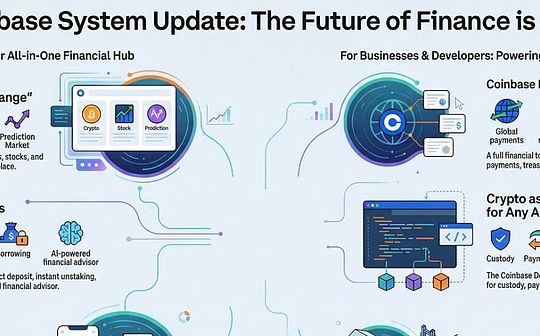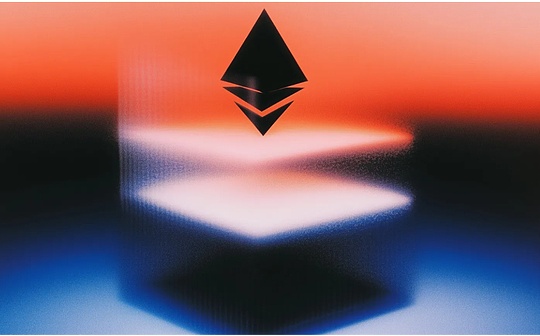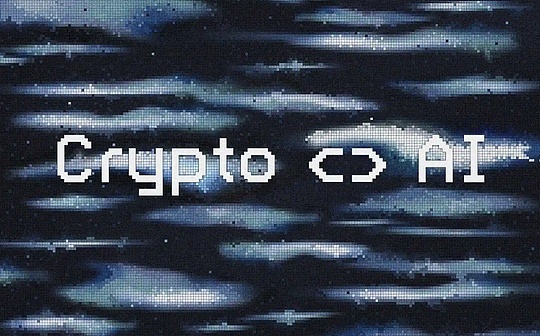
Author: Deep Value Memetics, Translation: Bit Chain Vision Xiaozou
In this article, we will explore the prospects of the Crypto X AI framework.We will focus on the current four major frameworks (Eliza, Game, ARC, ZEREPY) and their respective technical differences.
1. Foreword
We have studied and tested the four major Crypto X AI frameworks, the four major Crypto X AI frameworks of Eliza, Game, ARC, and ZEREPY in the past week. The conclusions we have drawn are as follows.
We believe that AI16Z will continue to dominate.Eliza’s value (market share is about 60%, and the market value exceeds US $ 1 billion) lies in its premier advantage (Lindy effect), and the use of more and more developers, 193 contributors, 1,800 bits of forksAnd more than 6,000 STAR and other data proves this, making it one of the most popular code libraries on Github.
So far, the development of Game (market share of about 20%and a market value of about 300 million US dollars) is very smooth, and it is being used quickly. As Virtual has just announced, the platform has more than 200 projects, 150,000 daily requests of 150,000 daily requestsAnd 200%weekly growth rate.Game will continue to benefit from the rise of Virtual and will become one of the largest winners in its ecosystem.
Rig (ARC, market share is about 15%, market value is about 160 million US dollars) is very noticeable because its modular design is very easy to operate and can be used as “Pure-Play”Essence
ZEREPY (market share is about 5%, and the market value is about 300 million US dollars) is a relatively niche application. It is dedicated to the enthusiastic Zerebro community. Its recent cooperation with the AI16Z community may have a synergy effect.
We noticed that our market share calculation covers market value, development records and underlying operating system terminal markets.
We believe that in this market cycle, the framework segment will be the fastest growing field. The total market value of $ 1.7 billion may easily increase to 20 billion US dollars. This is still relatively conservative compared with the peak valuation of L1 in 2021 L1.At that time, the valuation of many L1 reached more than $ 20 billion.Although these frameworks serve different terminal markets (chain/ecosystems), given that we believe that the field is in a rising trend, the weighted method of market value may be the most cautious method.
2. Four major frameworks
In the following form, we list the key technologies, components and advantages of each major framework.
>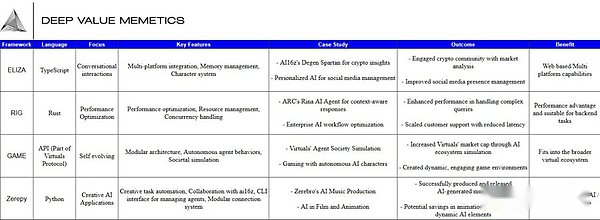
(1) Framework Overview
In the intersection of AI X Crypto, several frameworks have promoted the development of AI.They are AI16Z’s Eliza, Rig of ARC, ZEREBRO of ZEREPY, and Virtual of Games.Each framework meets different needs and concepts in the development of the AI agency, from open source community projects to corporate solutions that focus on performance.
This article first introduces the framework to tell everyone what they are, what programming language, technical architecture, algorithm, what unique functions, and what are the potential cases that the framework can use.Then, we compare each framework in terms of availability, scalability, adaptability and performance, and explore their respective advantages and limitations.
Eliza (developed by AI16Z)
Eliza is a multi -agent simulation open source framework, which aims to create, deploy and manage independent AI agents.It is developed in programming language in TypeScript. It provides a flexible scalable platform for constructing smart agents. These smart agents can realize interaction with humans on multiple platforms and maintain consistent personalities and knowledge.
The core function of this framework includes a multi -agency architecture that supports the deployment and management of multiple unique AI personality, as well as a character system that uses the character file framework to create different agents, as well as the long -term memory and context of the enhanced generation (RAG) system through advanced search (RAG) system (RAG) systemPerceived memory management function.In addition, the Eliza framework also provides smooth platform integration, which can be reliable with Discord, X and other social media platforms.
From the perspective of AI’s communication and media functions, Eliza is an excellent choice.In terms of communication, the framework supports integration with Discord’s voice channel functions, X functions, Telegram, and APIs used to customize cases.On the other hand, the media processing function of the framework can be extended to PDF document reading and analysis, link content extraction and abstract, audio transcription, video content processing, image analysis and dialogue, which can effectively handle various media input and output.
The Eliza framework provides flexible AI model support through the local reasoning of the open source model, the cloud push -ups of OpenAI, and the default configuration (such as Nous Hermes Llama 3.1B), and integrates support for complex tasks for Claude.Eliza uses a modular structure and has a wide range of operating systems, custom client support and comprehensive APIs to ensure scalability and adaptability between applications.
Eliza’s use cases span multiple fields, such as: AI assistants for customer support, community review and personal tasks, as well as social media roles such as automatic creators, interactive robots and brand representatives.It can also act as knowledge workers, play research assistants, content analysts, and document processors, and supports interactive roles in the forms of role -playing robots, educational mentors and entertainment agents.
Eliza’s architecture is built around the agent run (Agent Runtime), and the agency runtime is seamlessly integrated with its role system (supported by model provider), memory manager (connected to the database) and operating system (link with the platform client).The unique features of this framework include the plug-in system that supports modular function expansion, supports multi-mode interaction such as voice, text, and media, and is compatible with leading AI models (such as LLAMA, GPT-4, and Claude).With its diverse and powerful design, Eliza stands out as a powerful tool for cross -domain development of AI applications.
G.A.M.E (developed by Virtuals Protocol)
G.A.M.E (G.A.M.E) for generate -based autonomous autonomy aims to provide developers with AI and SDK access to AI proxy experiments.This framework provides a structured method to manage the behavior, decision -making and learning process of AI agents.
The core component is as follows: First of all, the agent prompting interface is the entry point where the developer integrates Game into the proxy behavior in the agent.Perception subsystems start the session by specifying parameters such as session ID, proxy ID, user and other related details.
It will integrate the information into the input mechanism of the AI agent in the format of the Strategic Planning Engine, whether it is in the form of dialogue or response.The core is the dialogue processing module, which is used to process messages and responses from proxy, and cooperates with the perception subsystem to effectively interpret and respond to input.
The strategic planning engine and the dialogue processing module and the wallet operator on the chain work together to generate response and plans.There are two levels of the engine function: as a high -level planner, a wide range of strategies are created according to the context or target; these strategies are converted into operational strategies as low -level strategies.Planning actuator for executing tasks.
Another independent but important component is the World Context. It quotes the environment, global information and game status to provide the necessary context for the decision -making of the agent.In addition, Agent Repository is used to store long -term attributes, such as goals, reflection, experience and personality, they jointly create proxy behaviors and decision -making processes.
The framework uses short -term work memory and long -term memory processors.The short -term memory retains the relevant information, results, and current planning related information.In contrast, long -term memory processors extracted key information to extract key information according to standards such as importance, recent nature, and correlation.Long -term memory stores the knowledge, reflection, dynamic personality, world -end context and work memory, to enhance decision -making and provide a learning foundation.
The learning module uses data from the perception subsystem to generate general knowledge. These knowledge is fed back to the system to improve future interaction.Developers can enter the feedback of action, game status and sensory data through the interface to enhance the learning ability of AI agents and improve their planning and decision -making capabilities.
The workflow began to interact at the developer through the agency prompt interface.The input is processed by the perception subsystem and reposted to the dialogue processing module. The dialogue processing module is responsible for managing interaction logic.The strategic planning engine then formulated and implemented the plan based on these information, and used high -level strategic and detailed action plans.
Data from the world’s context and agent repository notify these processes, while working memory tracking instant tasks.At the same time, long -term memory processor storage and retrieval long -term knowledge.Learn the results of the module and integrate new knowledge into the system, so that the behavior and interaction of the agent can be continuously improved.
Rig (developed by ARC)
Rig is an open source RUST framework, which aims to simplify the development of large language model applications.It provides a unified interface for interaction with multiple LLM providers (such as OpenAI and Anthropic) to support various vector storage, including MongoDB and Neo4J.The uniqueness of the modular architecture of this framework is its core component, such as the provider’s abstract layer, and the vector storage integration and proxy system to promote the seamless interaction of LLM.
RIG’s main audience includes developers using AI/ML applications using Rust, and secondly include the seeking to integrate multiple LLM providers and vectors into various organizations in their own Rust applications.The repository uses working spatial architecture, with multiple Crates, supports scalability and efficient project management.The key functions are the abstract layer of the provider, which provides standardization for the completion and embedding API between different LLM providers, and has consistent mistakes.Vector Store Integration component provides an abstract interface for multiple backend and support vector similar search.The proxy system simplifies LLM interaction and supports retrieval enhanced generation (RAG) and tool integration.In addition, the embedded framework also provides an embedded operation of batch processing functions and Type Safety.
Rig uses a number of technical advantages to ensure reliability and performance.The asynchronous operation uses RUST’s asynchronous operation to effectively process a large number of concurrent requests.The incorrect processing mechanism inherent in the framework improves the recovery ability of artificial intelligence providers or database operations.Type Safety can prevent errors in the compilation process, thereby enhancing the maintenance of the code.The efficient serialization and desertile process support the data processing of JSON and other formats, which is essential for AI service communication and storage.Detailed log records and detection further help debugging and monitoring applications.
Rig’s workflow starts when the client initiates a request. The request interacts with the appropriate LLM model through the provider abstract layer.The data is then processed by the core layer. In the core layer, the agent can use tools or access the context vector storage.In response, before returning to the client, it was generated and refined through complex workflows (such as RAG). The process involved document search and contextual understanding.The system integrates multiple LLM providers and vector storage, which is adaptable to model availability or performance updates.
There are many cases of RIG, including retrieval related documents to provide accurate response Q & A systems, document search and retrieval system for high -efficiency discovery, and chat robots or virtual assistants who provide customers with contextual understanding interaction.It also supports content generation, supports creation and other materials based on learning models, making it a general tool for developers and organizations.
ZEREPY (developed by Zerepy and BLORM)
ZEREPY is an open source framework written in Python language, which aims to use OpenAI or Anthropic LLM to deploy agents on X.A modular version derived from the ZEREBRO back end, Zerepy allows developers to start agents similar to the core function of Zerebro.Although the framework provides the foundation for agency deployment, it is essential to form creative output, fine -tuning models.ZEREPY simplifies the development and deployment of personalized AI agents, especially for content creation on social platforms, and cultivates an AI -driven creative ecosystem for art and decentralized applications.
This framework uses Python development, emphasizing agency autonomy, focusing on creative output generation, and consistent with Eliza’s architecture and cooperation with Eliza.Its modular design supports memory system integration and supports deployment agents on social platforms.The main functions include a command line interface for agency management, integration with Twitter, support for OpenAI and Anthropic LLM, and modular connection systems for enhanced functions.
The use case of ZEREPY covers the field of social media automation. Users can deploy artificial intelligence agents for release, reply, likes and forwards, thereby improving platform participation.In addition, it also caters to content creation in the fields of music, meme, and NFT, making it an important tool for digital art and blockchain -based content platforms.
(2) Comparison of four major frameworks
In our opinion, each framework provides a unique method for the development of artificial intelligence, which meets specific needs and environment. We transfer the focus from the competitive relationship of these frameworks to the uniqueness of each framework.
Eliza stands out with its user -friendly interface, especially for developers who are familiar with JavaScript and Node.js environment.Its comprehensive documents help setting artificial intelligence agents on various platforms, although its extensive functional set may bring a certain learning curve.Developed using TypeScript to make Eliza an ideal choice to build an agent embedded in the web, because most of the front end of the web infrastructure is developed with TypeScript.This framework is known for its multi -agency architecture and can deploy different artificial intelligence personality on platforms such as Discord, X and Telegram.Its advanced memory management RAG system makes it particularly effective for customer support or social media applications.Although it provides flexible, powerful community support and consistent cross -platform performance, it is still in the early stage and may constitute a learning curve for developers.
GAME is designed for game developers. It provides low -code or code -free interfaces through APIs, so that users with low technology content in the game field can also be used.However, it focuses on game development and blockchain integration, which may constitute a steep learning curve for those who have no relevant experience.It has outstanding performance in program content and NPC behavior, but it is limited by the complexity increased by its segments and blockchain integration.
Due to the use of the Rust language, the RIG may not be very friendly given by the complexity of the language, which brings major learning challenges, but for those who are proficient in system programming, it has intuitive interaction.Compared with TypeScripe, the programming language itself is known for its performance and memory safety.It has strict compilation inspection and zero percentage abstraction, which is necessary for running complex AI algorithms.This language is very efficient, and its low degree of control has made it an ideal choice for resource -intensive artificial intelligence applications.This framework provides high -performance solutions with modular and scalable designs, making it an ideal choice for corporate applications.However, for developers who are not familiar with Rust, using Rust cannot avoid facing steep learning curves.
ZEREPY uses Python to provide high degree of availability for creative AI tasks. Python developers have a low learning curve, especially for developers with AI/ML backgrounds, and have benefited from strong community support due to the encrypted community of Zerebro.Zerepy is good at creative artificial intelligence applications such as NFT and positioning itself as a powerful tool for digital media and art.Although it is booming in creativity, the range is relatively narrow compared to other frameworks.
In terms of scalability, Eliza has made great progress in its V2 update. It introduces a unified message line and scalable core framework to support effective management across multiple platforms.However, if no optimization is performed, this multi -platform interaction management may bring scalability challenges.
GAME performs well in real -time processing required by the game. The scalability is managed by high -efficiency algorithms and potential blockchain distributed systems, although it may be limited by specific game engines or blockchain networks.
The RIG framework uses RUST’s scalability properties to design it for high throughput applications, which is particularly effective for enterprise -level deployment, although this may mean that the real scalability requires complex settings.
ZEREPY’s scalability facing creative output and supports the support of community contributions, but its focusing center of gravity may limit its application in a wider artificial intelligence environment.Test.
In terms of adaptability, Eliza leads its plug -in system and cross -platform compatibility. GAME and RIG of complex AI missions in the game environment are also excellent.ZEREPY has shown high adaptability in the creative field, but is not suitable for wider artificial intelligence applications.
In terms of performance, Eliza optimizes rapid social media interaction. Rapid response time is the key, but its performance may be different when dealing with more complicated computing tasks.
GAME developed by Virtual Protocol focuses on high -performance real -time interaction in game scenarios, and uses efficient decision -making processes and potential blockchains for decentralized artificial intelligence operations.
The RIG framework is based on the RUST language, which provides excellent performance for high -performance computing tasks, and is suitable for calculating corporate applications with crucial efficiency.
The performance of ZeRepy is tailor -made for the creation of creative content. The indicators are centered on the efficiency and quality of content generation, and may not be very common outside the creative field.
Eliza’s advantage is that it provides flexibility and scalability. Through its plug -in system and character configuration, it has high adaptability, which is conducive to cross -platform social AI interaction.
GAME provides a unique real -time interactive function in the game, which enhances novel AI participation through the blockchain.
The advantage of RIG lies in its performance and scalability for corporate artificial intelligence tasks, focusing on providing clean modular code for long -term project health.
Zerepy is good at cultivating creativity, leading in digital art artificial intelligence applications, and supporting the vibrant community -driven development model.
Each framework has its own limitations. Eliza is still in the early stages. There are potential stability problems and new developer learning curves. The niche game may limit the widely used application, and the blockchain also increases complexity.Because the steep learning curve composed of RUST may scare some developers, ZEREPY’s small -scale attention for creative output may limit its use in other AI fields.
(3) Framework comparison summary
Rig (ARC):
Language: Rust, pay attention to safety and performance.
Example: ideal choice for enterprise AI applications because it focuses on efficiency and scalability.
Community: Not very driven by the community, pay more attention to technical developers.
Eliza (AI16Z):
Language: TypeScript, emphasizing the flexibility of Web3 and community participation.
Example: Designed for social interaction, DAO and transactions, especially emphasis on multi -agency systems.
Community: High community -driven, with extensive Github participation.
Zerepy (ZEREBRO):
Language: Python, so that it can be used for a wider range of AI developers.
Example: Suitable for social media automation and simpler AI agency tasks.
Community: relatively new, but due to the popularity of Python and the support of AI16Z contributors, it is expected to grow.
Gameal (Virtual):
Focus: Autonomous and adaptive artificial intelligence agents can evolve according to interaction in the virtual environment.
Use case: The most suitable AI agent learning and adaptation scene, such as games or virtual worlds.
Community: Innovate the community, but still determines its positioning in competition.
3. Star data trend on github
>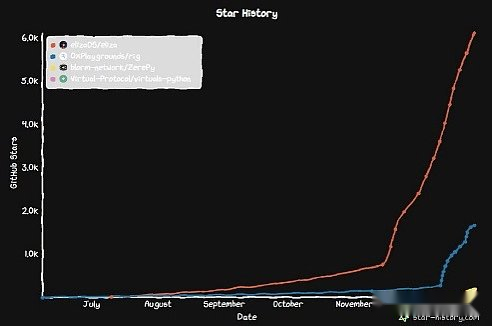
The picture above is the GitHub Star since the release of these frameworks.It is worth noting that GitHub Star is an indicator of community interests, project popularity, and project perception value.
Eliza (Red Line):
From the low base in July, the number of STARs in late November (reaching 61,000 stars), which indicates that people’s interests have increased rapidly and attracted the attention of developers.This index -level growth shows that Eliza has gained great appeal due to its functions, updates and community participation.Its popularity is far more than other competes, which shows that it has strong community support and has a wider applicability or interest in the artificial intelligence community.
Rig (blue line):
Rig is the longest of the four major frameworks. The number of stars is moderate but continued to grow, and it is likely to increase significantly in the next month.It has reached 1700 stars, but it is still rising.Continuous development, renewal, and increasing number of users are the reason for the continuous accumulation of user interest.This may reflect that the niche of the framework users may still accumulate reputation.
ZEREPY (yellow line):
Zerepy just launched a few days ago and has accumulated 181 stars.It is worth emphasizing that ZEREPY needs more development to improve its visibility and adoption rate.Cooperation with AI16Z may attract more code contributors.
Game (green line):
The number of stars in this project is the least. It is worth noting that this framework can be directly applied to the agent in the virtual ecosystem through the API, thereby eliminating the needs of Github’s visibility.However, this framework was open to the builders more than a month ago, and more than 200 projects are constructed using Game.
4. Reasons for the bullshit of the framework
Eliza’s V2 version will integrate Coinbase proxy kit.All projects using Eliza will support native Tee in the future, so that the agent can run in a safe environment.One feature of Eliza is the plug -in registry (Plugin Registry), which allows developers to seamlessly register and integrated plug -in.
In addition, Eliza V2 will support automated anonymous cross -platform messages.The token economics white paper is scheduled to be released on January 1, 2025, and it is expected to have a positive impact on the underlying AI16Z token of the Eliza framework.The AI16Z plan continues to enhance the effectiveness of the framework and continues to attract high -quality talents. The efforts of its main contributors have proved that it has this ability.
The Game framework provides an agent with codeless integration, allowing using Game and Eliza in a single project to serve specific purposes.This method is expected to attract the builders who are concerned about business logic rather than technical complexity.Although the framework has only been released for more than 30 days, with the support of the team’s efforts to attract more contributors, it has made substantial progress.It is expected that all items starting on Virtual will use Game.
RIG, represented by ARC tokens, has huge potential. Although its framework is still in the early growth stage, it is only a few days to promote the plan adopted by the project.However, the high -quality project of ARC is expected to appear soon, similar to the Virtual flywheel, but focused on Solana.The team is optimistic about cooperation with Solana and compares the relationship between ARC and Solana to Virtual to Base.It is worth noting that the team not only encourages new projects to use RIG startup, but also encourages developers to enhance the RIG framework itself.
ZEREPY is a newly launched framework that is getting more and more attention due to the cooperation with Eliza.The framework attracted Eliza’s contributors and they are actively improving it.Driven by Zerebro fans, it has a group of fanatical followers and provides new opportunities for Python developers. These developers have lacks representativeness in the competition of artificial intelligence infrastructure.This framework will play an important role in AI creativity.


